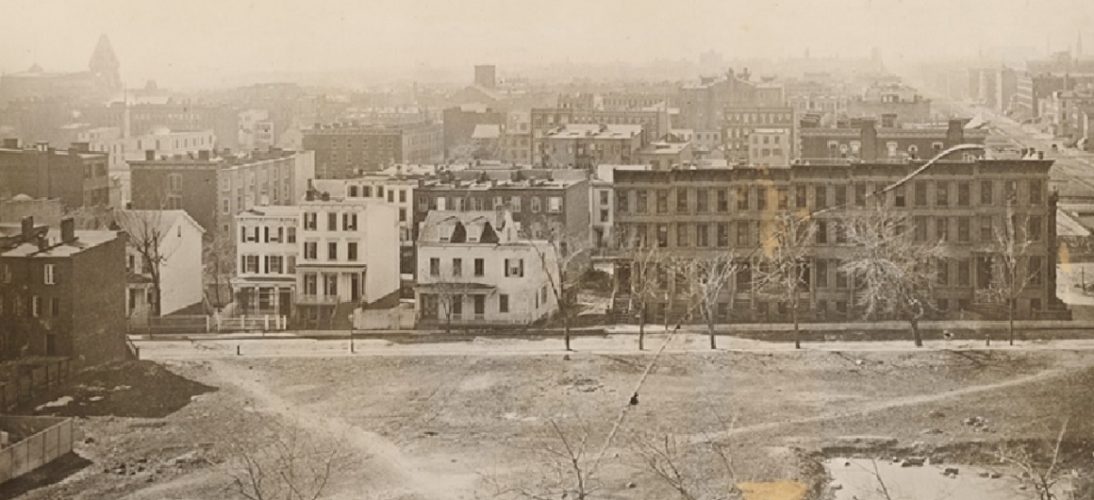 If you read the title of this post quickly you might have concluded it is about the Tennents as in the Log College’s William or Gilbert, but it is instead about the tenements in New York. The subject of crowded urban housing seems out of the realm of interest for B. B. Warfield given his legacy of defending the inspiration of Scripture, promoting Calvinism and its Augustinian roots, critiquing perfectionism, and defending the Westminster Standards against all comers. He has not been called “The Lion of Princeton” for nothing. But there is more to Warfield than his seminary classes and theological polemics, as the review transcribed in this post will show.
If you read the title of this post quickly you might have concluded it is about the Tennents as in the Log College’s William or Gilbert, but it is instead about the tenements in New York. The subject of crowded urban housing seems out of the realm of interest for B. B. Warfield given his legacy of defending the inspiration of Scripture, promoting Calvinism and its Augustinian roots, critiquing perfectionism, and defending the Westminster Standards against all comers. He has not been called “The Lion of Princeton” for nothing. But there is more to Warfield than his seminary classes and theological polemics, as the review transcribed in this post will show.
The titles reviewed are by Jacob Riis (1849-1914), an immigrant from Denmark who was socially influential in journalism and is credited with awakening the nation to the plight of New York’s immigrants. He exposed to the nation and the world the excessive hours of labor for meagre sustenance and over-crowded housing. His How the Other Half Lives, 1890, used not only text but also illustrations to tell the story of tenement dwellers. Warfield also mentions on the other end of the socio-economic scale Ward McAllister (1827-1895) whose autobiographical Society as I have Found It, 1890, shows unabashed fervor as he touted the lavish lifestyle of New York’s Gilded Age society.
Warfield’s indignation and fervor about the tenements are interesting given that he sometimes wrote to refute the increasingly vogue Ritschlian view that doctrine is in the doing rather than doctrine produces doing. The teaching of Albrecht Ritschl (1822-1889) contributed to a turn of American churches from the redeeming gospel to what developed essentially into a theological version of political progressivism. In this review Warfield’s systematics comes forth in applied theology as he expressed concern for his neighbors in New York tenements. He answered the question asked of Jesus by the lawyer, “Who is my neighbor?” (Luke 10:29), to which Jesus told the parable of the Good Samaritan (10:30-35). Dare it be said that the Kentucky gentleman was as enraged about the tenements as he was about C. A. Briggs and his denials of the inspiration and infallibility of Scripture?
Barry Waugh
The following review was published in Presbyterian and Reformed Review, Vol. 4, No. 16, 1893, 709-10. In the transcription comments were added in brackets and some archaic words were updated without notation.
How the Other Half Lives. Studies among the Tenements of New York. With Illustrations, by Jacob A. Riis, New York: Charles Scribner’s Sons, 1890.
The Children of the Poor, by Jacob A. Riis, illustrated, New York: Charles Scribner’s Sons, 1892.
The year of our Lord, 1890, witnessed the publication of two volumes, as widely contrasted as books could well be in the interests which they represent, and also in the trains of thought which they set in motion in reply to the two questions: “Who is my neighbor?” and, “Is life worth living?” We refer to Mr. Ward McAllister’s book, Society as I have Found It (and done my best to make and keep it), and the earlier of the studies by Mr. Riis now before us. They deal with different social strata and make a very different appeal to earnest minds. The momentous problems raised by the first mentioned of these volumes are the great concerns engaging the attention and energy of the reviser of guest lists, the designer of calling cards and the regulator of their use, the grand master of ceremonies, the chef de cuisine, tailors, milliners and modistes of every class and degree, and all who do, and all who would, belong to the very elect of social life, holding no life worth living except within that charmed circle. The problems of Mr. Riis’s volumes are of the most intense and painful interest to patriots, philanthropists, and Christians; to the supporters of all our great charities, organized and individual; to the heads and subordinates of the health, police, and educational departments in city and town; to all who are and all who should be advocates of municipal and social reform; to property owners who have consciences, or who hold themselves at all amenable to the great, but too often silent, public conscience, and, beyond that, to a divine law and a divine Judge; to all who are not infatuated to the verge of insanity in their optimistic view of the times in which we live and the perfection of our civilization.
The gravest and most formidable condonations of skepticism and atheism are found in just such specific facts and just such widespread conditions of things in this nineteenth of the Christian centuries as Mr. Riis here sets before us. It would require a novelist of the rarest power to conceive and describe what is here vividly and with becoming feeling delineated as awful reality. The revelations are appalling in the masses of fact and the details of fact which they bring out in the successive chapters, clinching all by a few pages of statistics in the Appendices. If it were destitution only that called for relief, the problem would be easy of solution. But the degradation and callousness that are possible to humanity so near to churches and universities and art museums and refined and Christian homes; the gross, inventive, defiant developments of vice and crime; the ever-present, ever obstructive and diabolical greed that mocks alike at legislation and at philanthropy; the close confederation of our debauched politics with many of the worst factors and forces in our social state; and the contented ignorance and apathy of the great body of those from whose action, individual and collective, relief must come—these are the more confounding elements in the situation.
The capacity of our nation and of our local communities for exertion and for self-sacrifice has been amply proved. Our power of national digestion and assimilation is being tested in recent years as never before, but not so much by the numbers as by the quality of the legions of immigrants who are pouring in upon us, and whose residence, temporary or permanent, in our great cities contributes some of its gravest elements to the complicated and oppressive problem that Mr. Riis brings so powerfully before us. The sickening facts that come out to public knowledge as the abominations of the “sweating’’ system [i.e. sweat shops] and kindred devices of selfishness and greed are exposed, are already influencing private action and will more and more compel concerted and legislative action. Consumers’ leagues are organizing, the members of which bind themselves not to deal with firms that refuse to pay living wages to employees; and we know Christian women who have for years refused to buy cheap, ready-made clothing. Morals will more and more compel recognition in economics as well as in politics. And the even more sickening facts of the condition and stunting of childhood in the homes (can we use that word here?)[i.e. can homes be homes when the residents live in squalor]) of the poor, ought to strike a chord of sympathy in every breast which will rouse to action. Mr. Riis’s evident care to avoid exaggeration; his recognition of certain alleviations inherent in child-nature and even in the situation itself; his far from hopeless and even in some respects cheerful outlook; only give an additional emphasis to the horror of the actual situation, and an additional spur to effort for its betterment.
Mr. Riis has rendered an immense public service to society and to Christianity by his painful and powerful presentation of facts which are of universal and immeasurable importance and urgency. The great, earnest, middle class in society may quietly ignore the pains and pleasures, the envvings and plottings of the coteries represented by Mr. McAllister. But to the great host for which Mr. Riis pleads they can never serenely pass on the message, “Stand by thyself; come not near to me” [Isaiah 65:5]. Humanly speaking, the hopes of society center in it.
Princeton, Benjamin B. Warfield
The image of tenements and New York is dated 1882 and it is from the New York Public Library Digital Collections. The catalog title is, “Tenements and row houses photographed from Jacob Ruppert mansion (5th Av & 93rd St).” Jacob Ruppert Sr. and Jr. were brewers; Jr. represented New York in the U.S. House of Representatives and he owned the Yankees.





